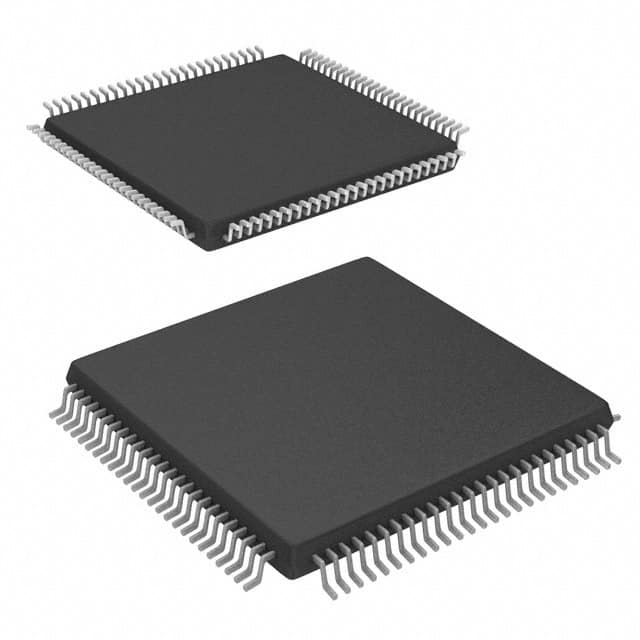Xem thông số kỹ thuật để biết chi tiết sản phẩm.

EPM7256AETI100-7N
Product Overview
Category
The EPM7256AETI100-7N belongs to the category of programmable logic devices (PLDs).
Use
This device is commonly used in digital circuit design and implementation. It offers flexibility and reconfigurability, allowing users to program its functionality according to their specific requirements.
Characteristics
- Programmable Logic Device (PLD)
- High-density integration
- Reconfigurable
- Low power consumption
- Fast operation speed
Package
The EPM7256AETI100-7N is available in a compact 100-pin Thin Quad Flat Pack (TQFP) package.
Essence
The essence of this product lies in its ability to provide a versatile and customizable solution for digital circuit design, enabling efficient and cost-effective implementation of complex logic functions.
Packaging/Quantity
The EPM7256AETI100-7N is typically packaged in reels or trays, with a quantity of 250 units per reel/tray.
Specifications
- Manufacturer: Intel Corporation
- Model: EPM7256AETI100-7N
- Technology: CMOS
- Number of Logic Elements: 256
- Number of I/O Pins: 100
- Operating Voltage: 3.3V
- Maximum Operating Frequency: 100 MHz
- Programmable Logic Cells: 5,760
- On-Chip Memory: 4,608 bits
- JTAG Boundary Scan Support: Yes
- Package Dimensions: 14mm x 14mm
Detailed Pin Configuration
The EPM7256AETI100-7N has a total of 100 pins, each serving a specific purpose in the device's operation. The pin configuration is as follows:
(Pin Number - Pin Name - Description)
1 - GND - Ground
2 - VCCIO - I/O Power Supply Voltage
3 - TDI - Test Data Input
4 - TMS - Test Mode Select
5 - TCK - Test Clock
6 - TDO - Test Data Output
7-10 - NC - No Connection
11-14 - IO[0:3] - General Purpose I/O Pins
15-18 - IO[4:7] - General Purpose I/O Pins
...
99 - VCC - Power Supply Voltage
100 - GND - Ground
Functional Features
The EPM7256AETI100-7N offers several functional features that enhance its usability and performance:
Programmability: The device can be programmed to implement a wide range of logic functions, allowing for flexibility in circuit design.
Reconfigurability: The programmable nature of the device enables easy modification of the implemented logic, facilitating iterative design processes.
High Integration: With 256 logic elements and 5,760 programmable logic cells, the EPM7256AETI100-7N provides high-density integration, enabling complex designs within a small footprint.
Low Power Consumption: The CMOS technology used in this device ensures low power consumption, making it suitable for battery-powered applications.
Fast Operation Speed: The EPM7256AETI100-7N operates at a maximum frequency of 100 MHz, ensuring efficient execution of logic functions.
Advantages and Disadvantages
Advantages
- Flexibility in circuit design
- Reconfigurable for iterative development
- High-density integration
- Low power consumption
- Fast operation speed
Disadvantages
- Limited number of I/O pins (100)
- Programming complexity for intricate designs
- Higher cost compared to fixed-function logic devices
Working Principles
The EPM7256AETI100-7N operates based on the principles of programmable logic. It consists of a matrix of configurable logic elements and programmable interconnects. The user programs the device by specifying the desired logic functions and interconnections using a hardware description language (HDL) or a graphical design tool. Once programmed, the device executes the specified logic functions, enabling the desired circuit behavior.
Detailed Application Field Plans
The EPM7256AETI100-7N finds applications in various fields, including:
Embedded Systems: Used for implementing control and communication functions in embedded systems such as industrial automation, robotics, and IoT devices.
Digital Signal Processing: Employed in digital signal processing applications, including audio and video processing, image recognition, and data compression.
Communications: Utilized in networking equipment, telecommunications systems, and wireless communication devices for protocol handling, data routing, and encryption.
Automotive Electronics: Integrated into automotive systems for controlling engine management, safety features, infotainment systems, and vehicle diagnostics.
Consumer Electronics: Found in consumer electronic
Liệt kê 10 câu hỏi và câu trả lời thường gặp liên quan đến ứng dụng EPM7256AETI100-7N trong giải pháp kỹ thuật
Sure! Here are 10 common questions and answers related to the application of EPM7256AETI100-7N in technical solutions:
Question: What is the EPM7256AETI100-7N?
Answer: The EPM7256AETI100-7N is a specific model of programmable logic device (PLD) manufactured by Intel.Question: What is the purpose of using the EPM7256AETI100-7N in technical solutions?
Answer: The EPM7256AETI100-7N is used for implementing digital logic functions in various applications, such as industrial control systems, telecommunications equipment, and automotive electronics.Question: What are the key features of the EPM7256AETI100-7N?
Answer: The key features of this PLD include 256 macrocells, 100-pin TQFP package, 7ns maximum propagation delay, and support for various I/O standards.Question: How can I program the EPM7256AETI100-7N?
Answer: The EPM7256AETI100-7N can be programmed using industry-standard hardware description languages (HDLs) like VHDL or Verilog, and then configured using programming tools provided by Intel.Question: Can the EPM7256AETI100-7N be reprogrammed after initial configuration?
Answer: No, the EPM7256AETI100-7N is a one-time programmable device, meaning that once it is configured, the programming cannot be changed.Question: What voltage levels does the EPM7256AETI100-7N support?
Answer: The EPM7256AETI100-7N supports a wide range of voltage levels, including 3.3V, 2.5V, and 1.8V, making it compatible with various system requirements.Question: Can the EPM7256AETI100-7N interface with other components or devices?
Answer: Yes, the EPM7256AETI100-7N has multiple I/O pins that can be used to interface with other components or devices, allowing for seamless integration into larger systems.Question: What is the maximum operating frequency of the EPM7256AETI100-7N?
Answer: The maximum operating frequency of the EPM7256AETI100-7N depends on the specific design and implementation, but it can typically reach frequencies in the range of tens to hundreds of megahertz.Question: Are there any limitations or considerations when using the EPM7256AETI100-7N?
Answer: Some considerations include power supply requirements, thermal management, and ensuring proper signal integrity in high-speed designs. Referring to the datasheet and application notes provided by Intel is recommended.Question: Where can I find additional resources or support for using the EPM7256AETI100-7N?
Answer: You can refer to the official Intel website for datasheets, application notes, and technical support related to the EPM7256AETI100-7N. Additionally, online forums and communities dedicated to programmable logic devices can provide valuable insights and assistance.

